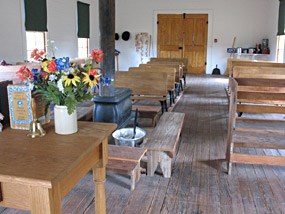
The one-room school was very important to the rural people living in Gillespie County. Here, near their homes, the children learned the "3R's" - reading, writing, and arithmetic - enabling many of them to go on to high school and college. The schools were located close enough to children's homes to allow to them to walk to school. There were 31 one-room schools located in Gillespie County; only one - Doss School - remains in operation today.

The History of the Junction School The first one-room schoolhouse on the Pedernales River was actually a tent in the Christadelphian campgrounds one mile east of the present day Junction School. In 1882, the tent was replaced by the community with a small frame building that served both as a school and church. On September 27, 1910 John Pehl sold to the school district 2 3/4 acres of land on the north side of the Pedernales River to a build a new school. The fall term opened in the new school on November 21, 1910. The Junction School served the area for over 37 years. In the spring of 1947 the Junction School became part of the Stonewall Consolidated School District. This move closed the Junction School and the students attended the nearby Stonewall School. In 1972 the National Park Foundation purchased the land to become part of the Lyndon B. Johnson National Historical Park. 
The Junction School was a typical one-room school. A wood stove sat in a sand box in the center of the school and was the only source of heat. Two kerosene lamps suspended from the ceiling at opposite ends of the room provided light. The teacher's desk and a chair were in front of the classroom. A small brass bell on the teacher's desk summoned the students. Students sat at double desks which had wooden tops with holes for the glass inkwells. The desks were arranged in rows facing the teacher's desk; the boys in one row and the girls in another.

The Future President Starts School One of the students at the Junction School was a 4-year old boy by the name of Lyndon Baines Johnson. He was born just up the road from the school on August 27, 1908 to the proud parents Sam and Rebekah Johnson. A typical little boy, he liked to ride his horse and play with other children and his dog, Bigham Young. Since Lyndon could hear the children outside before school and at recess, he would run down to the school house to play with them. His mother - constantly worried he would get lost - talked to the teacher, Miss Katie Deadrich, about enrolling him early into school. As an adult, President Johnson loved to relate how he had insisted upon sitting in Miss Katie's lap for his reading lessons. Johnson only attended Junction School for several months in 1912 since the school closed early due to a whooping cough epidemic. His family moved to Johnson City by the start of the next school year. In 1924, he graduated from high school in Johnson City and later attended Southwest Texas Teachers' College in San Marcos where he received his teaching degree. Johnson taught school for a while in Houston, Cotulla, and Pearsall, Texas. 
LBJ Library Photo by Frank Wolfe The Education President The Johnson Administration saw the passage of over 60 education bills, more education legislation than in any other presidential administration. In comparison, only six major education bills were passed from the time of Lincoln to Kennedy. With such an interest in education, it was only fitting that President Johnson would come back to his first school to sign one of these major education bills. Sitting at a picnic table on the lawn of the Junction School with Miss Katie Deadrich (his first teacher) at his side, President Johnson signed the Elementary and Secondary Education Act on April 11, 1965. 
LBJ Library Photo by Frank Wolfe "No measure I have signed, or will ever sign, means more to the future of America...." Provisions of the
|
Last updated: March 31, 2012
